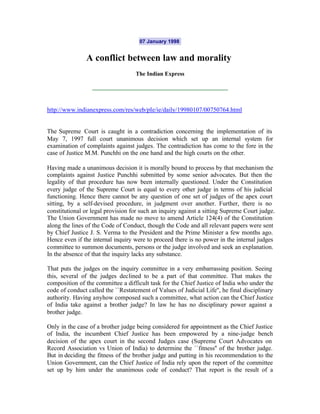
Law vs Morality: SC Caught in Code of Conduct Contradiction
- 1. 07 January 1998 A conflict between law and morality The Indian Express http://www.indianexpress.com/res/web/pIe/ie/daily/19980107/00750764.html The Supreme Court is caught in a contradiction concerning the implementation of its May 7, 1997 full court unanimous decision which set up an internal system for examination of complaints against judges. The contradiction has come to the fore in the case of Justice M.M. Punchhi on the one hand and the high courts on the other. Having made a unanimous decision it is morally bound to process by that mechanism the complaints against Justice Punchhi submitted by some senior advocates. But then the legality of that procedure has now been internally questioned. Under the Constitution every judge of the Supreme Court is equal to every other judge in terms of his judicial functioning. Hence there cannot be any question of one set of judges of the apex court sitting, by a self-devised procedure, in judgment over another. Further, there is no constitutional or legal provision for such an inquiry against a sitting Supreme Court judge. The Union Government has made no move to amend Article 124(4) of the Constitution along the lines of the Code of Conduct, though the Code and all relevant papers were sent by Chief Justice J. S. Verma to the President and the Prime Minister a few months ago. Hence even if the internal inquiry were to proceed there is no power in the internal judges committee to summon documents, persons or the judge involved and seek an explanation. In the absence of that the inquiry lacks any substance. That puts the judges on the inquiry committee in a very embarrassing position. Seeing this, several of the judges declined to be a part of that committee. That makes the composition of the committee a difficult task for the Chief Justice of India who under the code of conduct called the ``Restatement of Values of Judicial Life'', he final disciplinary authority. Having anyhow composed such a committee, what action can the Chief Justice of India take against a brother judge? In law he has no disciplinary power against a brother judge. Only in the case of a brother judge being considered for appointment as the Chief Justice of India, the incumbent Chief Justice has been empowered by a nine-judge bench decision of the apex court in the second Judges case (Supreme Court Advocates on Record Association vs Union of India) to determine the ``fitness'' of the brother judge. But in deciding the fitness of the brother judge and putting in his recommendation to the Union Government, can the Chief Justice of India rely upon the report of the committee set up by him under the unanimous code of conduct? That report is the result of a
- 2. committee set up by a decision on the administrative side of the court. Hence it cannot fall in the category of judge- made law pending suitable legislation by Parliament -- an area of law- making now given by the court to itself in public interest litigation cases. Moreover, the first judges case (S. P. Gupta vs Union of India) and the second Judges case made it clear that decision- making could not be left in the hands of a single person, the Chief Justice of India. Does the Chief Justice of India consult his other colleagues before making his recommendation by taking into account the report of the committee constituted by him? And does he talk about this to the brother judge who would be affected by his recommendation?If the brother judge ultimately finds his claim to Chief Justiceship denied to him by the Union Government, then what is his remedy? If he resigns then he loses straightaway because the Delhi High Court five-judge bench in P. N. Lakhanpal vs A. N. Ray held that seniority cannot be an argument if the senior ones have already resigned in protest. If he challenges it without resigning then a serious problem arises about the constitution of the bench to hear such a case and his access to the documents which are classified as secret. This brings out the other irony -- the ``Restatement'' with the two resolutions passed unanimously by the apex court have been kept secret by the court. This must be the world's only code of conduct regarding holders of public office about which the public has no knowledge. The supreme irony in this classic conflict between law and morality is that the court is keeping it secret as to whether Justice Punchhi, as a judge of the court on May 7, 1997, was a party to the unanimous decision on the Code of Conduct. This is important given the powerful dissent of Justice Punchhi in the second Judges case as to how he was presented with a fait accompli of the common judgment of five judges written by Justice J. S. Verma (as he then was.) Implementation of the unanimous decision concerning the high courts is also problematic. Several of the high courts have agreed to the code of conduct only subject to a major reservation. This reservation is concerning the Chief Justice of India being the final disciplinary authority. The agreement of the High Courts is also on the administrative side and not by a judgment and accordingly it cannot have the legally binding force of the latter. Once again, the list of High Courts which have made this reservation is classified as a ``top secret'' document by the apex court which in at least three cases of high court judges has operated the internal committee mechanism. The secrecy itself poses a moral issue for the apex court. Copyright © 1998 Indian Express Newspapers (Bombay) Ltd.